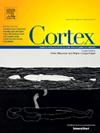Data-driven classification of narrative speech characteristics in stroke aphasia distinguishes neurological and strategic contributions
IF 3.3
2区 心理学
Q1 BEHAVIORAL SCIENCES
引用次数: 0
Abstract
Narrative speech deficits are common in post-stroke aphasia, resulting in negative influences on social participation and quality of life. Speech rate, complexity, and informativeness deficits all contribute to narrative speech. Research studies typically (implicitly) assume that these aspects of narrative speech production are a result of cognitive/neurological impairment, but they may also result from strategic choices made as individuals with aphasia attempt to produce narrative speech. Here, we used data-driven methods to classify aphasic narrative speech patterns and evaluated their predictability from lesion patterns. 76 stroke aphasia patients completed 11 narrative speech production tasks. Quantitative Production Analysis (QPA) and Correct Information Unit (CIU) analysis were used to measure their structural and functional properties. Based on prior work, we selected QPA measures of speech rate (words per minute) and complexity (mean sentence length, inflection index, and auxiliary index) and four CIU measures of informativeness (#CIU, CIU/min, %CIU, #nonCIU). These measures produced two orthogonal dimensions with four orthogonal participant clusters. Comprehensive comparison between clusters revealed that speech rate and complexity were strongly associated with general aphasia severity and total lesion volume, and were predicted by frontoparietal grey matter and dorsal pathway white matter damage. In contrast, informativeness was independent of other behavioral and neurological deficits, and was not predictable from lesion patterns, suggesting that it reflects communication strategy rather than specific neurological impairment. These results provide an important step toward distinguishing neurological and strategic aspects of narrative speech deficits in post-stroke aphasia, with potential implications for treatment approaches that target communication strategies.
脑卒中失语症叙述性言语特征的数据驱动分类区分神经和策略的贡献
叙述性言语缺陷在卒中后失语症中很常见,对社会参与和生活质量产生负面影响。语速、复杂性和信息性缺陷都会导致叙事性言语。研究通常(含蓄地)假设叙事性言语产生的这些方面是认知/神经障碍的结果,但它们也可能是失语症患者在试图产生叙事性言语时所做出的策略选择的结果。在这里,我们使用数据驱动的方法对失语叙事语言模式进行分类,并从损伤模式评估其可预测性。76例脑卒中失语症患者完成11项叙事言语生成任务。使用定量生产分析(QPA)和正确信息单元(CIU)分析来测量它们的结构和功能特性。基于之前的工作,我们选择了语音速率(每分钟字数)和复杂性(平均句子长度,屈折指数和辅助指数)的QPA度量和四个CIU信息性度量(#CIU, CIU/min, %CIU, #nonCIU)。这些措施产生了两个正交的维度,四个正交的参与者集群。综合比较发现,言语速度和复杂程度与一般失语严重程度和总损伤体积密切相关,并可通过额顶叶灰质和背侧通路白质损伤预测。相比之下,信息性独立于其他行为和神经缺陷,并且不能从病变模式中预测,这表明它反映的是沟通策略而不是特定的神经损伤。这些结果为区分卒中后失语症中叙述性言语缺陷的神经学和策略方面提供了重要的一步,并对针对沟通策略的治疗方法具有潜在的影响。
本文章由计算机程序翻译,如有差异,请以英文原文为准。
求助全文
约1分钟内获得全文
求助全文
来源期刊

Cortex
医学-行为科学
CiteScore
7.00
自引率
5.60%
发文量
250
审稿时长
74 days
期刊介绍:
CORTEX is an international journal devoted to the study of cognition and of the relationship between the nervous system and mental processes, particularly as these are reflected in the behaviour of patients with acquired brain lesions, normal volunteers, children with typical and atypical development, and in the activation of brain regions and systems as recorded by functional neuroimaging techniques. It was founded in 1964 by Ennio De Renzi.
 求助内容:
求助内容: 应助结果提醒方式:
应助结果提醒方式:


